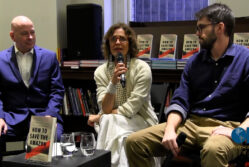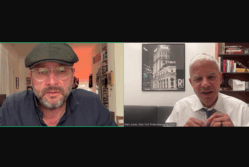Event Coverage Highlight

OPC Photo Award Winners Share Tips With Columbia J-School Crowd
Photojournalists working in conflict areas face increasing risks that heighten the need for safety and good planning.
Working with dependable fixers, staying in touch with editors and building trust with subjects were among the many tips that two OPC award-winning photographers and a photo editor shared during a panel discussion on best practices in international reporting on Thursday, Sept. 25 at the Columbia University School of Journalism.
James Estrin, a co-editor of The New York Times Lens Blog, told a crowd of mainly journalism students that getting good images requires patience and time to devote to the subject.
“The first thing that I look for in photographs are photographs that make me feel something. I want to be moved,” he said. He also looks for “accuracy” and a profound knowledge of the subject matter. “I’m not only looking for the photograph, I’m looking actually for the photographer.”
OPC board member Robert Nickelsberg, who won the OPC’s 2013 Olivier Rebbot Award for his book Afghanistan: A Distant War, agreed that it takes time to get people used to the camera. He recommended meeting a respected elder in a community quickly to help ease suspicions.
Nickelsberg also told the audience that, when working in hostile areas, choosing and developing trust with a local driver is critical for photojournalists.
“They’re basically your eyes and ears and navigator of a new terrain or environment.” he said. “They’re the cat’s whiskers of any trip. They’re so terribly important.”
He cautioned against disclosing too much information about your project or plans, since drivers and fixers are sometimes interrogated or extorted for information.
Sarah Voisin, a photographer for the Washington Post who won the OPC’s 2009 John Faber Award for her photos of Mexico’s drug war, recalled getting stuck in a sketchy situation while covering the funeral of two drug cartel members in Mexico. She was alone and had taken a bus to the burial site with members of the funeral party. At the site, some friends of the deceased became aggressive.
“I had no way to leave,” she said. She ended up leaving in the hearse as young gang members chased them down the road. “You definitely need a second set of eyes and your own transportation.”
During a Q&A session, a student asked the three panelists about the role of technology and social media.
Voisin said photographers are increasingly expected to be able to juggle other kinds of media during their time in the field.
“Making yourself a well-rounded videographer, in addition to a social media expert and storyteller is good,” she said.
Estrin, who recommended that starting photographers use social media like Instagram to gain exposure for their work, said digital technology has been a boon to photographers, with one key caveat.
“The one drawback of digital (photography) is the speed,” Estrin said. Digital technology allows photoraphers to shoot thousands of photos per day. With film, you have to consider each of your shots more carefully, he said. “You have to think and see.”
Nina Berman has curated a photo exhibit on the 3rd floor that will remain open until the end of October, featuring work by Tyler Hicks, Robert Nickelsberg and Jerome Delay of AP, who won the John Faber Award for his photos of unrest in the Central African Republic.



